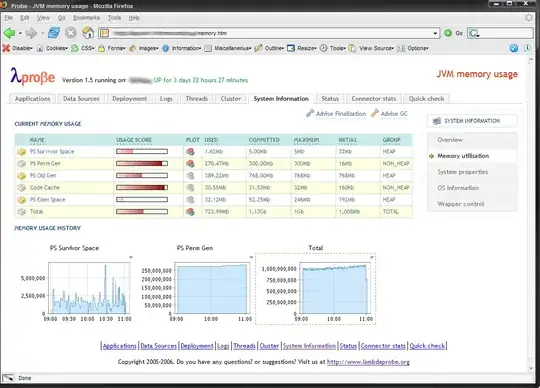we are trying to investigate memory usage of java process under moderate load.
PID USER PR NI VIRT RES SHR S %CPU %MEM TIME+ COMMAND
12663 test 20 0 8378m 6.0g 4492 S 43 8.4 162:29.95 java
As you can see we have resident memory at 6Gb. Now the interesting part is this: the process is executed with these params:
- -Xmx2048m
- -Xms2048m
- -XX:NewSize=512m
- -XX:MaxDirectMemorySize=256m
- ... some others for GC and stuff
Looking at these settings and at actual memory usage we are stumbled to see the difference of what we expect this process to be using and what it actually uses.
Usually our memory problems are solved by analyzing heap dump but in this case our memory is used somewhere outside heap.
Questions: What would be the steps to try and find the reason of such a high memory usage? What tools could help us identifying what uses the memory in that process?
EDIT 0
It doesn't look like this is a heap related problem as we still have quite some space there:
jmap -heap 12663
results in (edited to save space)
Heap Configuration:
MinHeapFreeRatio = 40
MaxHeapFreeRatio = 70
MaxHeapSize = 2147483648 (2048.0MB)
NewSize = 536870912 (512.0MB)
MaxNewSize = 536870912 (512.0MB)
OldSize = 1610612736 (1536.0MB)
NewRatio = 7
SurvivorRatio = 8
PermSize = 21757952 (20.75MB)
MaxPermSize = 85983232 (82.0MB)
New Generation: 45.7% used
Eden Space: 46.3% used
From Space: 41.4% used
To Space: 0.0% used
concurrent mark-sweep generation: 63.7% used
Perm Generation: 82.5% used
EDIT 1
using the pmap we can see that there are quite some amount of allocations of 64Mb:
pmap -x 12663 | grep rwx | sort -n -k3 | less
results in:
... a lot more of these 64Mb chunks
00007f32b8000000 0 65508 65508 rwx-- [ anon ] <- what are these?
00007f32ac000000 0 65512 65512 rwx-- [ anon ]
00007f3268000000 0 65516 65516 rwx-- [ anon ]
00007f3324000000 0 65516 65516 rwx-- [ anon ]
00007f32c0000000 0 65520 65520 rwx-- [ anon ]
00007f3314000000 0 65528 65528 rwx-- [ anon ]
00000000401cf000 0 241904 240980 rwx-- [ anon ] <- Direct memory ?
000000077ae00000 0 2139688 2139048 rwx-- [ anon ] <- Heap ?
So how to find out what are those 64Mb chunks? What is using them? What kind of data is in them?
Thanks
